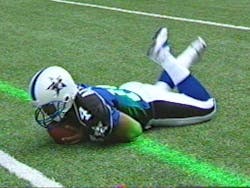NFL football could benefit from first-down laser system
Miami Beach, FL--Alan Amron, inventor and founder of First Down Laser Systems, told USA TODAY Sports that he has met with NFL football executives several times because he has recently completed a first-down laser marking system that could prevent problems like the officiating snafu that disrupted the December 1 Washington Redskins' final drive in a loss to the New York Giants. "Everybody knows about us, but until something like this happens, they don't realize how important having the [first-down] line on the field just like you see on TV is to the game," said Amron, 65, a New York native and professed Giants fan.
According to Amron, the football tracking system includes a projector mounted at the base of the flagstick containing nothing but aluminum mirrors, plus a small fiber-optic cable. The cable runs to an underground into a tunnel, where it connects to a 100 W laser measuring roughly 3 feet by 3 feet. The projector can be remotely controlled by the referee and an operator in the broadcast booth. When a measurement is needed, the laser can be turned on to project a 4-inch-wide green line across the field, almost instantly determining whether a first down has been achieved.
The first demonstration of the system occurred more than a decade ago. An initial meeting with the competition committee was set up by Amron's co-founder, the late former NFL player and broadcaster Pat Summerall. At that point, the idea was to project the line from the stadium lights. "The bottom line was the NFL liked the excitement of having the (yard sticks) on the field," Amron said. "So, we built it into the chain staff, and that was about two years ago. We finally finished the product now, and we're all ready to go into a game."
Depending on the stadium, Amron says, each system would cost $180,000 to $245,000, a minor investment for a multibillion-dollar industry that surely could sell sponsorships for the equipment, too.
NFL spokesman Greg Aiello told USA TODAY Sports in an e-mail that any talks about implementing Amron's system or something similar would be "an offseason discussion by the Competition Committee." In January, Aiello told the Associated Press that the league had "not been convinced" Amron's system would work for the league.
"This is the first year the NFL is considering fan experience number one. What better for fan experience than having the line they're used to at home in the stadium, where they're paying $200 a seat?" Dean Blandino, the NFL's vice president of officiating, admitted in a statement Monday that officials made multiple errors after a 4-yard completion to Redskins receiver Pierre Garcon was spotted just shy of a first down with a little less than 2 minutes to go and the Giants leading 24-17.
Head linesman Phil McKinnely incorrectly motioned for the chains to move without getting a first-down signal from referee Jeff Triplette, who should have stopped play because of "obvious confusion as to the status of the down." The moving chains and Redskins coach Mike Shanahan's assertion that an official told him it was first down (rather than third-and-1) contributed to the team's subsequent play call, according to quarterback Robert Griffin III, whose downfield pass was dropped by tight end Fred Davis. The Redskins actually converted on fourth-and-1 following the misfire to Davis, but Garcon was stripped by Giants safety Will Hill, sealing the victory for New York.
The technology has been tested in college track-and-field events and a United Football League scrimmage, but not a live football game, Amron said. He hopes that'll change as soon as next year, if an upcoming demonstration goes well for Canadian Football League officials.
SOURCE: USA TODAY Sports; https://www.usatoday.com/story/sports/nfl/2013/12/02/first-down-laser-system-officiating-error-redskins/3809743
About the Author

Gail Overton
Senior Editor (2004-2020)
Gail has more than 30 years of engineering, marketing, product management, and editorial experience in the photonics and optical communications industry. Before joining the staff at Laser Focus World in 2004, she held many product management and product marketing roles in the fiber-optics industry, most notably at Hughes (El Segundo, CA), GTE Labs (Waltham, MA), Corning (Corning, NY), Photon Kinetics (Beaverton, OR), and Newport Corporation (Irvine, CA). During her marketing career, Gail published articles in WDM Solutions and Sensors magazine and traveled internationally to conduct product and sales training. Gail received her BS degree in physics, with an emphasis in optics, from San Diego State University in San Diego, CA in May 1986.
